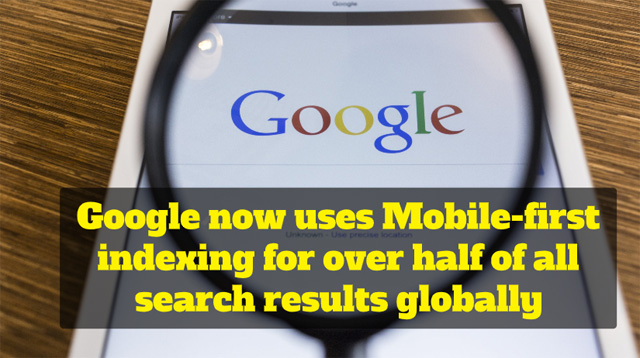Half of search results pages using mobile-first indexing
January 31, 2019
Google is now using mobile-first indexing for over half of all web pages. Websites that aren’t designed with mobile devices in mind should plan for this. This post explains more about what this means and how it impacts your website.

What is Google’s mobile-first Index
Why it matters to every website
How to tell if your site is using mobile-first indexing
What steps (if any) you need to take
Quick Takeaways
Before we get started, think for a second on something we all take for granted – Google. Google literally has to process millions of search queries every single minute and return instant results. Not only does it have to do this, it has to do it accurately and quickly. It also has to keep track of millions of brand new web pages published every month and compare them to pages already published. And that’s only part of what Google does.
What is Google’s Mobile-First Index
Let’s start with the term “Google Index”. This term refers to all the individual web pages in the universe that Google is aware of. Every time a user types in a search query, it compares all the pages in the Index with the search query, ranks them accordingly, and returns the results. There are a number of factors the Google algorithm considers when matching pages with queries, but that discussion’s for another post.
Remember, just because a web page is published and public, doesn’t necessarily mean it’s in the Google Index.
Smart Phones Changed Things

Smartphones changed the way people search and use the Internet. Prior to smartphones, everyone browsed and searched on desktop computers. Web sites and pages were designed and built accordingly. When Google first developed their algorithm to score and rank webpages, it used the desktop version of the page’s content to score the page.
Now that phones, tablets and high speed wifi are ubiquitous – both website design and the way people search the web continues to change. For example, I might browse the same website on my way to work using an iPhone as I do at work at my desktop or at home on my Surface Pro. As a user I want this experience to feel seamless.
The way people search has also evolved. More people started searching on Mobile than on Desktop in 2016 and it has continued to grow ever since. Google decided to change how they index web pages in response to this.
In 2016, Google announced that it had started the process of migrating sites for mobile-first indexing. This was a huge deal for anyone managing a website because it marked a fundamental change in the way Google indexed and ranked web pages. From that point on, Google began to first use the mobile version of a web page for indexing and ranking, instead of the desktop version. If a website does not have a mobile version, the desktop version will still be used.
Why it Matters to Every Website

People and businesses want to attract more visitors and traffic to their website (If you’re not interested in this you can stop reading now). If your website is not mobile-responsive, or it displays different information in mobile versus desktop view – your ranking position could be impacted. Additionally, this could be an opportunity to outrank a competitor site or gain visibility through mobile optimization.
Google still has one index and there are not separate indexes for mobile and desktop. Moving forward it will just use the mobile version first rather than the desktop. Half of the websites have been migrated over to this type of indexing so far.
How to Tell if Your Site is Using Mobile-First Indexing
The best way to verify this is by using Google Search Console (formerly known as Webmaster Tools). This is a completely free tool, from Google, that is relatively easy to setup. At VWM, our agency all but insists that every single website we work with uses this tool. Google will notify you when migrating to the mobile-first indexing. They will also give you other tips and advice on how to optimize your website or fix related issues.
Read our guide on Google Search Console, Google Analytics and Google Tag Manager here.
What Steps (if any) You Need to Take

Mobile-responsive sites are good to go and should be impacted by the mobile-first indexation changes. Keep in mind there is a difference between mobile-friendly and mobile-responsive. Generally speaking, a mobile-responsive site means your content dynamically syncs between desktop and mobile views and generally sends the same HTML code regardless of the device that is requesting it. Mobile-friendly can refer to sites that conform to mobile, but the content might change slightly between desktop and mobile views – impacting how your mobile page is scored vs your desktop page.
You should also make sure to install Google Search Console on your website. You will be notified if your site has been migrated over. If your site hasn’t been migrated over already, you still have time to make adjustments or changes to help take advantage when it migrates over.
Quick Takeaways
- Google has already migrated about half of all websites and continues to work on the remaining sites
- Mobile-responsive sites should generally be fine and have no issues
- Take 5 minutes to setup Google Search Console
- This can be an opportunity to rank higher or a sign it’s time to build a new website
Other Resources:
Mobile-first and SEO article from MOZ









